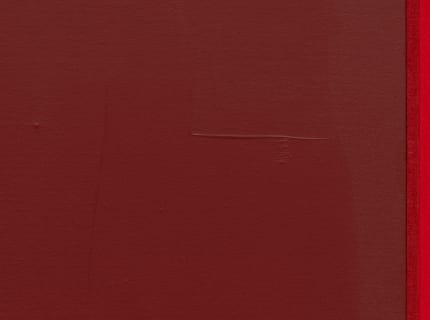I was born in Cincinnati and live and work in Hudson, New York. My interdisciplinary practice seeks to engage viewers visually and aurally. Drawing on painting, sculpture, sound, and installation, my conceptual works reflect on the legacy of Modernism and Minimalism. Their unconventional materials and reductive compositions highlight the perception of sound within the visual arts.
Articulating the relationship between sound and physical matter, my ongoing series of acoustic panel paintings incorporate noise-absorbing acoustic panels. The minimalist works juxtapose these panels with solid and two-tone expanses of color, and draw on imagery that recalls the geometry of musical notation, including bars, crescendos, and measures. Developing alternative ways to illustrate sonic experiences, other paintings from the series boast narrow strips of pigment applied along the edges of their canvases – an effect that causes their compositions to resonate with an echoed glow of color. Meanwhile, more recent acoustic panel paintings interact with the architecture of the spaces they inhabit, escaping the confines of the wall and becoming sculptural as they engage with the floor. Encouraging viewers to anticipate sound even in the quietest of environments, the acoustic panels in the paintings are always 'active'.
I always say they’re active even when there’s no sound in the room; they are affecting the subtlest of sounds in the space – dampening and absorbing even the human voice. Seamlessly integrating visual practices with auditory ones, the works underscore the connection between minimalism and music, recovering the legacy of the Black avant-garde.
The idea of lack can be turned on its head in order to be perceived as pure potential and opportunity. Perhaps this relates directly to African American improvisation and creative utility, to working inventively with spare means. I remain very grateful for my early [art school] experiences, which sparked two things: a deep appreciation of history and art history, and a desire to question it. Where was I in that history? To be at once a part of and an interloper in the context of art-making. [...] In hindsight, I’ve come to understand that what I’ve really been trying to unpack is the radicality of refusal and the courage that it requires.
In support of this recovery, for more than a decade, I have created sound pieces that micro-sample and distort disparate recordings. The resulting audio collages, which take Black avant-garde sonic movements as their source material, continue the artist’s project of challenging the dominant narrative of modernism by foregrounding African American cultural histories. Advocating for a holistic approach to the 20th-century canon, the work ultimately brings to light the systemic inequalities that shape who and what is seen and heard.

